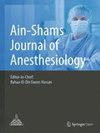Dexmedetomidine or magnesium to control agitations in patients undergoing tonsillectomy: randomised controlled study
IF 0.5
Q4 ANESTHESIOLOGY
引用次数: 0
Abstract
Abstract Background Preoperative time is a very stressful time for most patients undergoing surgery, particularly young patients. The primary goal of an anaesthesiologist is to reduce patients’ anxiety before surgery. To lessen this stress response, many anaesthetic pre-medications are used. Magnesium chloride and dexmedetomidine are two of these pre-medications that work well as sedatives. This study examined dexmedetomidine and magnesium sulphate as a pre-anaesthetic medication for kids. Dexmedetomidine and magnesium will be compared for their efficacy and safety in treating children who experience emerging anxiety after having their tonsils removed in this trial. Forty-five children between the ages of 4 and 12 years who were having elective adenotonsillectomy surgery in this comparative prospective, double-blind, randomised controlled clinical research. Children were split up into three groups: group A was given dexmedetomidine, group B was given magnesium infusion, and group C was given normal saline 0.9% infusion. Results Ramsay and Cravero scores revealed that children who got dexmedetomidine infusion were less agitated than those who received magnesium sulphate or normal saline infusion ( p value 0.01). Conclusions When comparing dexmedetomidine to magnesium sulphate, there are a few advantages to its use. It can be administered as an anaesthetic medication to minors undergoing adenotonsillectomy under general anaesthesia in order to lessen postoperative agitation.右美托咪定或镁控制扁桃体切除术患者的躁动:随机对照研究
背景对于大多数接受手术的患者,尤其是年轻患者来说,术前时间是一个非常紧张的时间。麻醉师的首要目标是减少病人在手术前的焦虑。为了减轻这种应激反应,使用了许多麻醉前药物。氯化镁和右美托咪定是其中两种作为镇静剂效果很好的前用药。本研究考察了右美托咪定和硫酸镁作为儿童麻醉前药物的作用。在这项试验中,右美托咪定和镁在治疗扁桃体切除后出现焦虑症状的儿童方面的疗效和安全性将进行比较。在这项比较前瞻性、双盲、随机对照的临床研究中,45名年龄在4至12岁之间接受选择性腺扁桃体切除术的儿童。将患儿分为3组:A组患儿给予右美托咪定,B组患儿给予镁注射液,C组患儿给予0.9%生理盐水注射液。结果Ramsay和Cravero评分显示右美托咪定组患儿的躁动程度低于硫酸镁组和生理盐水组(p值0.01)。结论右美托咪定与硫酸镁比较,其使用优势较少。它可以作为麻醉药物给未成年人在全麻下进行腺扁桃体切除术,以减少术后躁动。
本文章由计算机程序翻译,如有差异,请以英文原文为准。
求助全文
约1分钟内获得全文
求助全文

 求助内容:
求助内容: 应助结果提醒方式:
应助结果提醒方式:


